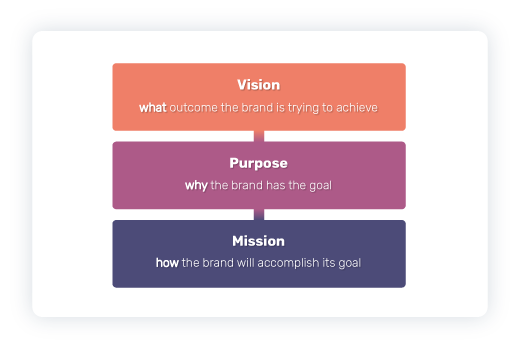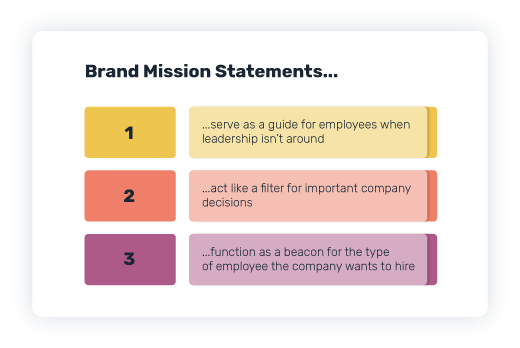Many startups eventually stop growing because they don’t have a meaningful brand mission. Today, you’ll see why something as simple as a mission statement can drive sustained growth for any company.
"Your mission doesn't change. Its ethos doesn't change. But how you articulate it in each given time period and as your product set changes, obviously is going to change."
Neal Behrend, Brigit
Today, we’ll explain what a brand’s mission is, share some classic examples, and show you how to create a powerful brand mission statement that can align teams, increase sales momentum, and ultimately, help you become the market leader.
Plus, we’ve got special guest Neal Behrend from fintech startup Brigit to share how their brand’s mission influences everything from recruiting, to product features, to even the company name.
What’s a Brand Mission Statement?
A brand’s mission is a marketing concept that describes how the brand will fulfill its ultimate purpose with its customers. And a mission statement is the simplest explanation of this goal.
Brand mission statements are often used alongside a brand purpose and vision statements to collectively communicate to its employees the how (i.e., brand mission), why (i.e., brand purpose) and what (i.e., brand vision) behind a brand’s existence.

The brand vision explains what outcome the brand is trying to achieve. The brand’s purpose describes why the brand has the goal, but the brand’s mission statement describes how the brand will accomplish its goal.
Brand missions, along with vision and purpose, are easy enough to understand, but deserve health contemplation and require deep insight for them to be effective drivers of long-term growth.
Why Are Brand Mission Statements so Important?
Now, there isn’t complete agreement on what goes into a brand mission or how to create one, but if you’re doing it right, your brand’s mission statement accomplishes a few important things.

First, it serves as a guide for employees when leadership isn’t around. In those scenarios where there aren’t any rules or it’s not clear how people should act, the brand’s mission statement should serve as a reminder of what the default behavior for everyone should be.
Second, it acts like a filter for important company decisions. When the product team is thinking about new features, the brand’s mission can help determine which features belong on the product road map. When the marketing team chooses to support a social cause, the brand’s mission will help them choose ideas that will be seen as helpful and not pandering. And so on.
Third, it functions as a beacon for the type of employee the company wants to hire. Companies with strong missions attract more passionate, productive, and loyal employees than brands that don’t. Mission-driven employees are 54% more likely to stay at a company for five years than people motivated by compensation alone.
3 Examples of a Strong Brand Mission Statement
OK now that we know what a brand mission is and why they’re important, let’s cement our knowledge with a short quiz. I’ll give you the brand mission. You guess the brand. Ready?
First, which brand has the mission to “inspire and develop the builders of tomorrow”?
If you guessed LEGO’s mission statement, you’re 100% right.
Next, which brand is on a mission to “bring the best user experience to its customers through its innovative hardware, software and services”?
If you knew that was Apple’s mission statement, you win again.
And last but not least, which brand’s mission is to “bring inspiration and innovation to every athlete in the world”?
You probably knew that was Nike’s mission statement.
How Should Startups Think About Their Brand Mission?
Startups have their own special challenges when it comes to mission statements. It can be hard to know or articulate a mission early on, and even then, it’s easy to pick a mission that becomes confining as the company grows.
To help us think through the importance of a brand’s mission in the early days, today we welcome Neal Berhend to Growing Brands. Neal is the VP and Head of Growth at Brigit, a financial health app on a mission to help improve the financial futures of Americans.
We had a chance to ask him about the relationship between brand mission and company growth.
Watch the interview to hear Neal answer these questions:
- Does Brigit have a formal or informal mission statement and if so, what is it?
- How has the mission helped with recruitment of employees and building the team culture?
- In what ways does the brand mission guide the decisions of the different teams at Brigit?
Brand Mission Statements, in Closing
If you liked this episode then take a few seconds to subscribe or download our brand mission worksheet (scroll up) or subscribe to our newsletter which contains exclusive brand measurement and growth marketing tips that I don’t share anywhere else.
Ok, it’s your turn…
What importance does your company place on the brand mission? As an employee, does it play a big role in deciding which company to work for? As a consumer, does it influence which brands you buy from?
Let me know by leaving a comment real quick before you leave.
Transcript from our interview with Neal Behrend:
So does Brigit have a formal or an informal mission statement? And if so, what is it? Yeah, so we don't have a formal written mission statement. I mean, one of the things that's really exciting about being at a really early stage startup is, you have a guiding light, but having a written mission statement kinda locks you in, and so you keep evolving and moving on this path. But we know what our mission is. We want to help our users reduce their financial stresses. We wanna increase financial wellbeing. We wanna help our users live their best financial lives because we think that'll make them most able to live their best lives, in all different aspects. So we think about that a lot and I can tell you that has been very core for as long as I've been at Brigit, and I think for a very long time. I think the way we actually write that in each individual iteration, I mean obviously it's really different when we had a thousand customers, than now when we have a million customers. And so thinking about it at the beginning, it was all about overdraft fees and we really expanded. We want to make sure our customers never have an overdraft fee. And now we've expanded far beyond that to really thinking about how stressed are you about money and can we make you less stressed? And I think your mission doesn't change, but your written mission does, right? Yeah, that's a good distinction. Right, and I think like that's where if your written mission is changing, then I think that makes sense because you're continuing to evolve and understand better what drives your customers and what they're really using your service for. But if your overall core mission, like if we ever decided that what we were not, I think I would feel very differently if our company was well like, Hey, we're removing financial stress and we're identifying that financial stress used to be overdraft fees and now we're thinking about high interest rate lenders and we're thinking about if the next step is people being concerned about unemployment around coronavirus. We were thinking about that very heavily right now. And the answer is those are all financial stress. And how we choose to articulate that in a written mission statement is going to change over time, because, please god, coronavirus will not be a source of financial stress forever. And so your mission doesn't change, its ethos doesn't change, but how you articulate it in each given time period and as your product set changes, obviously it's gonna change. That's really well said. So, how does your mission help with recruitment of employees and building the team culture at Brigit? It is such a valuable component. When you first start a company, culture is defined by, in my mind, culture is defined by having a strong mission and people aligned around it. You're gonna have people with different skillsets. Everyone is going to be, when you're like starting a company, not at Brigit, but at a prior organization there were eight, and I was employee number eight. And so going through and growing at that size, your mission is what holds the team together. And it helps define your culture. When you talk about recruitment, It's actually a really good double edged sword. You can ask questions about your mission, make sure that people are aligned with it, see if they have past actions that show that they're aligned with your mission. And so you can use it both to screen out people who aren't right, as well as also over select for people who really get your mission. Okay, last question for you then. In what ways does a brand mission guide the decisions of the different teams at Brigit, not just the recruiting team, but maybe product or growth or other functions? If everyone is bought into your vision, into your mission, then all these different teams, they have kind of this core understanding of what you're trying to accomplish, and so they're all just talking about different ways of accomplishing it, and they can have really rational fact-based conversations of I think we should do X I think we should do Y. Well, how do we decide which of those two we want to do? Which is most aligned with our mission? And so we really can apply a framework around it. And I know that the product team is applying the same kind of framework and maybe we make different assumptions, but the product team is thinking similarly to the growth team, is things similarly the marketing team. You know, hey, here's how we talk about these things. It's always about the same kind of principle. How do we reduce financial stress? Those are excellent thoughts for how a brand mission can lead to growth. So, Neal Behrend thank you so much for your time. Absolutely.


